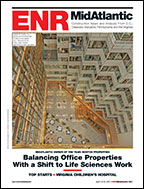A beleaguered epoxy supplier has called on the National Transportation Safety Board to correct several adverse findings regarding the July 10, 2006 Interstate 90 tunnel plenum collapse that killed a 38–year–old local woman.
NTSB found at a public hearing exactly one year later that the use of fast–set epoxy proven unable to support sustained loads caused the anchor bolts to creep out. NTSB criticized epoxy supplier Powers Fasteners, Inc., Brewster, N.Y., because it "failed to provide the Central Artery/Tunnel project with sufficiently complete, accurate and detailed information about the suitability of the company's fast–set epoxy for sustaining long–term tensile loads." The I–90 tunnel is part of the $14.8 billion CA/T project.
|
Powers supplied the epoxy to distributor, Newman, Renner, Colony, Canton, Mass., and helped NRC in mid–1999 put the Powers line and a private label NRC line on the Massachusetts Highway Department qualified construction materials list. Both labels contain the same standard–set and fast–set epoxies. "Powers had informed both the MHD and the distributor who was directly dealing with those contractors responsible for the oversight and construction of the I–90 connector tunnel, that the fast–set of its Power–Fast epoxy, unlike the standard–set, had failed creep tests," writes Martin E. Levin, attorney with Stern Shapiro Weissberg & Garin LLP, Boston. He asks that NTSB strike statements charging that Powers failed to provide complete information and that the information it did provide was misleading or incomplete. "The NTSB seems to have concluded that no one associated with the project was focused on the difference between fast–setting and standard epoxy," says Levin. "The fact is that even before the ceiling was installed state highway officials were focused on that very issue."
A series of memos in July 1999 from Simpson Gumpertz & Heger, Inc, Waltham, Mass, which helped get the lines on the state list, clearly indicate that the epoxies had been tested for International Conference of Building Officials approval but that the fast-set did not pass high–temperature creep tests. One memo to file based on a discussion with Powers employees notes they said "all amine based fast–set epoxies do not meet the elevated temperature creep requirements by a significant margin. Their fast–set epoxy does meet the room temperature creep requirements. It does have ICBO acceptance for short–term loading due to seismic and wind events." The information was passed on to an MHD official in July. The state official could not comment on the record. "Simpson Gumpertz & Heger was retained in 1999 by Newman Renner Colony in NRC's efforts to secure a place on the Massachusetts Highway Department statewide approved products list for some of its epoxy products. SGH's work was unrelated to the I–90 Connector Tunnel. SGH did no testing. SGH received product information and testing and evaluation reports from NRC and Powers, and in turn provided those materials to MHD," says an SGH spokesperson. NTSB has not yet responded.
MHD approved both product lines on April 27, 2000 without differentiating between standard–set and fast–set. Both the Powers and NRC lines are still on the state list. The Powers line uses blue labels for its standard–set epoxy and red labels for the fast–set. NRC used gold labels for both but standard–set is printed on the appropriate label. NRC did order standard–set epoxy for the tunnel plenum anchors in June 1999 but the epoxy did not arrive until sometime in August. NRC fast–set was used for wall panels and later for ceiling bolts possibly from July 1999 through March 2000. Normally, if a product is not on the approved list it must be removed from the job.
When the bolts let go ten precast concrete panels and hardware, weighing 52,000 lb, fell killing Melina Del Valle and injuring her husband, who was driving the couple to Logan International Airport.
 Related Links:
Related Links:
